Grieving Landscapes: An Interview with Nico Lawson
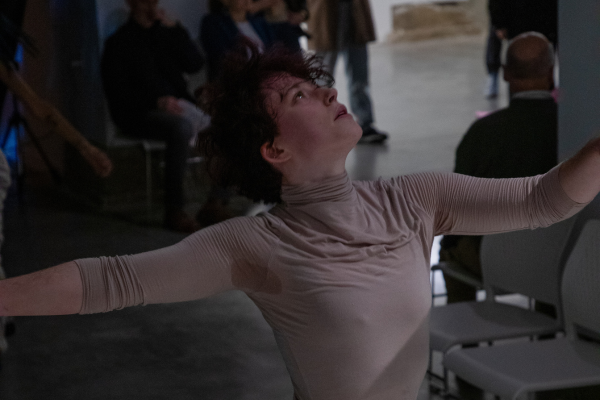
This interview was conducted prior to Nico’s performances in January 2024. Please join us in reflecting on Nico’s work in Grieving Landscapes and their collaboration with the inaugural Urban Arts Space Community Artist-in-Residence, Arris' J. Cohen, for his exhibition Fervent Fruition.
Watch the Grieving Landscapes performance and join the dancers for an artist talk in the video below!
How have your personal experiences with grief over tragedies both global and personal shaped the presentation of your exhibition?
CW: Suicide
I am speaking from the micro-individual level here. I am from a rural town in the foothills of the Appalachian Mountains in North Carolina called Sandy Ridge. Being from a rural area that is primarily evangelical Christian, funerals and other forms of community grieving were a common part of my upbringing, from religious services to preparing food for and sitting with the bereaved. Having this experience meant that my baseline understanding of grief was that it was not just something communal—it was something spiritual, sacred, and holy. It revealed the depths of our love and our hopes for futures without suffering.
This baseline also means that it has been striking to me when I found experiences of grief that were excluded from this sacred, communal process. My first conscious memory of this was the loss of a friend to suicide in middle school. Without the full support of the community—especially religious community—I remember my classmates and I feeling lost and confused with nowhere to put the depths of our loss and pain and somehow expected to carry on preparations for end-of-year testing.
Once you’ve seen behind the veil, you can’t unsee it. There is so much to grieve—the personal and the global are intimately intertwined—and so much pressure to grieve it quietly and carry on. For this exhibition I am honoring the need to have marginalized pain held in community and in the open—for the grief of experiences of marginalization to be held in a sacred space where we allow our hope for futures without suffering to run free.
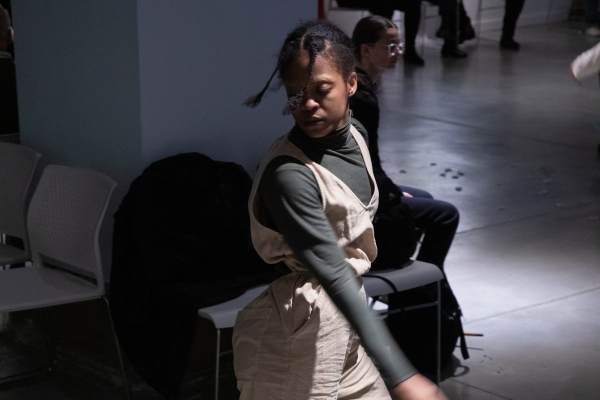
With identity playing a key role in each of these shows, how do you see your work reflecting the experiences of and uplifting marginalized identities?
I want to start with the transparent answer that this work addresses my own experience of grief over my identity. I was not able to come out as queer or non-binary until my late twenties, and was similarly not diagnosed with autism until my late twenties. Early research for this project came from investigations into the embodiment of the impact of these losses and the frustration of feeling that I had nowhere to put or process this type of complicated grief.
In inviting my collaborators into the process, my hope has been to build a supportive community where we could speak about our experiences of grief related to our identities and hold each other in our processes of metabolizing our grief and healing. We’re a mostly queer, racially and ability diverse group of women and women-aligned people. We are asking the audience to witness our grief and not look away. An example of this is a section of the performance that was born from a conversation between me and a collaborator about the ways that coming out and finding intimacy in queer community saved our lives. We ask each other, and the audience, questions like, “When did you realize you could think about your life in the future tense?...When did you realize that you would live to become an elder?” Living under white supremacist, cishetero-partiarchy, survival is not guaranteed for everyone and even when you do survive it comes at a cost of your physical, emotional, and spiritual well-being including your sense of safety and belonging. This part of the piece asks the audience to witness the bittersweetness of survival as we grieve what it took for us to live and the memories of our siblings that didn’t.
The conversation that generated this section also included honest discussion of how the cost of survival is not the same for all identities. As a white person who was socialized as and perceived as a white woman, there are types of grief that I will always be protected from. In this work I have attempted to hold the tension of the coexistence of privilege and marginalization. It is also my responsibility to bear witness to my more marginalized siblings and to hold boundaries around my privileged identities while doing so.
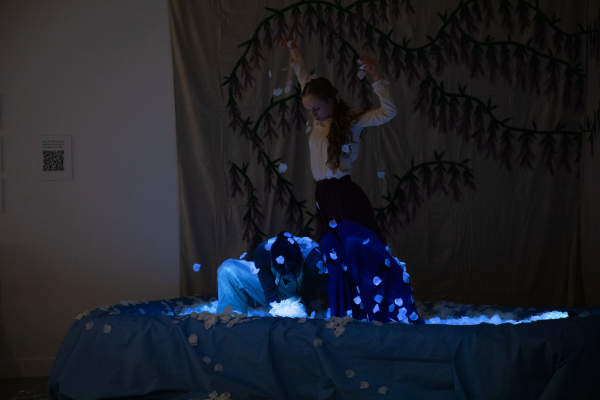
How do you feel your chosen mediums represent your skills as an artist while expressing the thematic elements you wish to convey?
My first inclination is to say that grief is an embodied experience. Not only are there physical processes that our bodies go through while we are grieving, but there are also physical practices associated with grieving, at least when we consider grieving the death of a loved one. I am thinking about the care taken to prepare a body, preparing food for the bereaved, preparations for burial, for example. As a performance artist that frequently draws on quotidian and ritualistic practices, it makes sense to bring these embodiments and physical practices into my personal dance practice.
I am also excited to build an installation that invites visitors to have an embodied experience beyond the performance that incorporates these physical practices; from leaving lifelines in yarn and written notes to physical spaces for rest and meditation. I wanted gallery visitors and audience members to be able to participate in the process with us, so I have created physical environments to invite them into the dance of Grieving Landscapes.
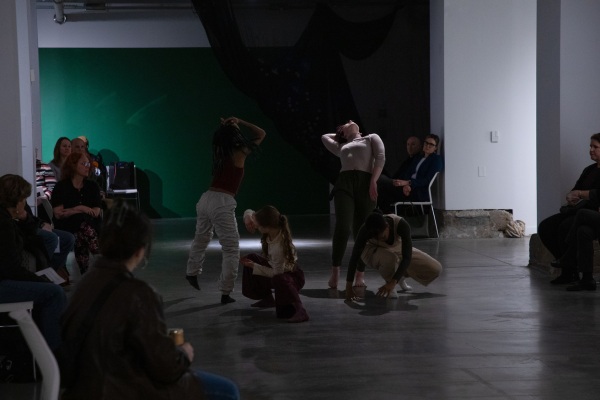
In what ways do you feel live performances impact audiences differently than installations?
For me, live performance captures the part of us that craves connection in real-time. I recently learned the term “collective effervescence.” It’s the term that people use to describe the collective emotional rush that people experience in community at music concerts and religious rituals. My understanding is that it’s related to kinesthetic empathy, which is the physical, empathic, sometimes mirroring response that we feel while watching a live performance. All of this to say that it seems to me there is something about sharing physical space and collective witnessing that captures our hearts and spirits in a way that experiencing something individually can’t. As a person with spiritual leanings, I am inclined to say that this is sacred, but I’ll let everyone draw their own conclusions.
Your poem “A Eulogy for Wisteria” tells of a journey of grieving and healing in a society that minimizes the importance of these rituals. How do you feel artistic endeavors can be used in the grieving process?
So much art has been created out of grief. A significant amount of research for Grieving Landscapes has been investigating the work and practice of artists and activists that work with and from marginalized grief—Neil Greenburg, Okwui Okpokwasili, Patrisse Cullors, the political funerals of activist groups like Black Lives Matter and ACT UP, even OSU’s own Crystal Perkins.
For myself personally, dancing and writing poetry have been methods and emotional/embodied spaces to process my experience—both painful and otherwise—when other means of communication and sense-making weren’t available to me. Understanding now that I have autism, these artistic practices have served as a way to share my inner world and connect with others that share my experience, including grief. I think when considering marginalized grief, artistic endeavors serve many purposes. They are a connection point for people that otherwise might grieve in isolation. They are a memorial and tracing of lives and experiences that might otherwise be forgotten or erased. They are a space to do the work of grief physically and emotionally—feel the despair, feel the anger, hold on to each other for dear life, even laugh. I feel that artistic endeavors create a safe container for our humanity in the context of grief.
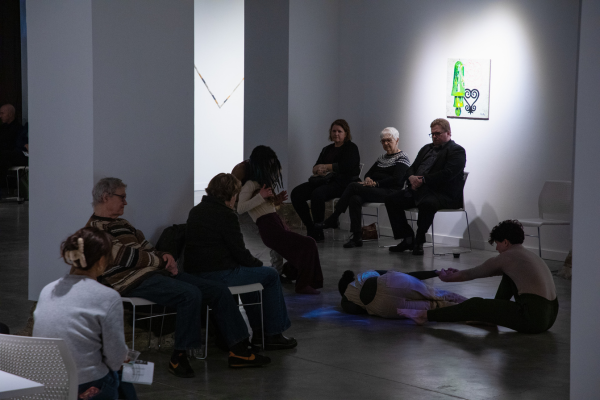
Who has been your biggest inspiration in life and as an artist?
Oo…this one is tough! I have many inspirations, but right now I want to shout out my community for supporting me through the process of creating this project. They inspire me to keep moving every day.
Jackie Courchene-Spayd—Thank you for being my unofficial committee chair. I don’t know where I would be without your willingness to let me verbally process my ideas or your willingness to always call me into my integrity. Your humor, compassion, hugs, and extra-strong margaritas have gotten me through.
Alex Benecke—Thank you for supporting all my crazy ideas from transporting 600 pounds of sand to making two trips to Walmart in the same day for supplies to build the container for said 600 pounds of sand. Your unconditional love and superb playlist-making skills bring me joy even in the most challenging moments.
Dorian Ham—you rock! I am so excited to be working with you and feel incredibly honored to be making the transition from student to collaborator with this project.
My collaborators—Yitong Chen, Siera Dance, Mercedes Hicks, and Britni Van Dine—I am so honored to be working with all of you. Your creativity, risk-taking, and empathy have moved this project into an incredibly beautiful place, and I cannot wait to celebrate what we have accomplished together. Much love to you all!
